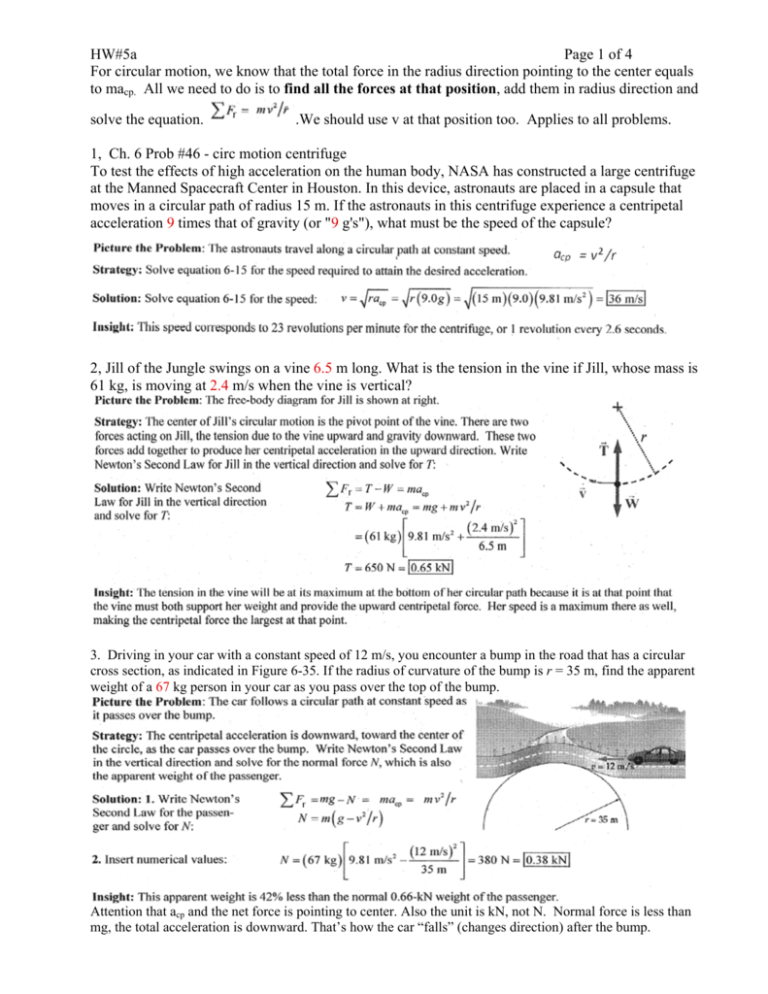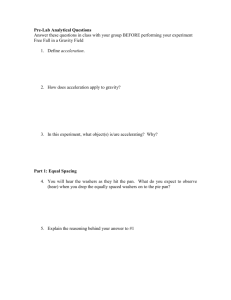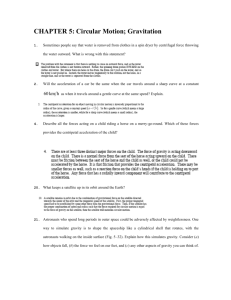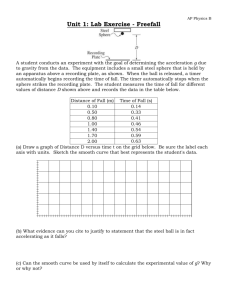HW#5a Page 1 of 4 For circular motion, we know that the total force
advertisement

HW#5a Page 1 of 4 For circular motion, we know that the total force in the radius direction pointing to the center equals to macp. All we need to do is to find all the forces at that position, add them in radius direction and solve the equation. .We should use v at that position too. Applies to all problems. 1, Ch. 6 Prob #46 - circ motion centrifuge To test the effects of high acceleration on the human body, NASA has constructed a large centrifuge at the Manned Spacecraft Center in Houston. In this device, astronauts are placed in a capsule that moves in a circular path of radius 15 m. If the astronauts in this centrifuge experience a centripetal acceleration 9 times that of gravity (or "9 g's"), what must be the speed of the capsule? 2, Jill of the Jungle swings on a vine 6.5 m long. What is the tension in the vine if Jill, whose mass is 61 kg, is moving at 2.4 m/s when the vine is vertical? 3. Driving in your car with a constant speed of 12 m/s, you encounter a bump in the road that has a circular cross section, as indicated in Figure 6-35. If the radius of curvature of the bump is r = 35 m, find the apparent weight of a 67 kg person in your car as you pass over the top of the bump. Attention that acp and the net force is pointing to center. Also the unit is kN, not N. Normal force is less than mg, the total acceleration is downward. That’s how the car “falls” (changes direction) after the bump. HW#5a Page 2 of 4 4. A 0.075 kg toy airplane is tied to the ceiling with a string. When the airplane's motor is started, it moves with a constant speed of 1.21 m/s in a horizontal circle of radius 0.44 m, as illustrated in Figure 6-40. Find the angle the string makes with the vertical and the tension in the string. Notice that the circular motion is in the horizontal plane. The center is at the center of that circle but not the point on the ceiling. The radius of this motion is the radius of that circle, not the length of the string. The acceleration and total net force is pointing to the circle center along the horizontal plane. It is important to identify there are only 2 forces. Tension and mg. Decompose Tension along horizontal plane and along vertical direction. Because the net force is in horizontal plane and there is no acceleration in vertical direction (y direction). This problem requires some 9th grade algebra equation solving skills. 5. A hockey puck of mass m is attached to a string that passes through a hole in the center of a table, as shown in Figure 6-46. The hockey puck moves in a circle of radius r. Tied to the other end of the string, and hanging vertically beneath the table, is a mass M. Assuming the tabletop is perfectly smooth, what speed must the hockey puck have if the mass M is to remain at rest? (Use g for acceleration due to gravity, and m, r, and M as necessary.) sqrt(Mrg/m) Notice that for the hockey puck the total force in radius direction is T. When you submit answer to this kind of question, click the “eye” icon to check your format. Do not include v = in your answer. HW#5a Page 3 of 4 6, . Pulley Problem: An object of mass m1 (= 30 kg) sits on a horizontal frictionless table. A rope is attached to it, which runs horizontally to a pulley , then down to a hanging mass m2 (= 5 kg). m1 x T T = m1 a T m2 W − T = m2 a W (Please use the x and y directions shown to answer the questions below.) a.) Find the acceleration of each mass, and the size of the tension in the rope: (Note: Make sure to find the general expressions first; this is an extremely important skill. Only after that, plug in the numerical values.) m1: ax = m/s2 , ay = m/s2 m2: ax = m/s2 , ay = m/s2 T = N (Is it less, the same, or more than the weight of m2? Does this make sense?) Checking limits: Using your general expression from above, b.) if m1 was instead zero, what would be the acceleration of m2? ax = m/s2 , ay = m/s2 c.) if m2 was instead zero, what would be the acceleration of m1? ax = m/s2 , ay = m/s2 (Do your answers from part b/c agree with your intuition?) d.) In general, with this pulley set-up, is it possible for m1 to remain stationary? What about if the table was not frictionless? Explain. Solution. See the free-body diagrams and Newton's-law equations above next to the picture. There are two simultaneous equations, with two variables, the tension and the acceleration. They are solved as follows: (1) T = m1a ( 2) W − T = m2 g − T = m2 a Use (1) to eliminate T from (2). m2 g − m1 a = m2 a m2 g = ( m1 + m2 ) a Then from (1) above we can find the tension: T=g or a = g m2 m1 + m2 m1 m2 m1 + m2 Putting in the numbers, m1 = 30 kg and m2 = 5 kg, gives a = 1.4 m/s 2 T = 42 N HW#5a Page 4 of 4 2 Translating this to the boxes above gives ax = 1.4 m/s , ay = 0 for m1, and ax = 0, ay = -1.4 m/s2 for m2. We note that the tension is less than the weight of m2, m2g=49 N. This agrees with the drawing, where the weight overcomes the tension and makes m2 accelerate downwards. (b) Suppose m1 = 0. Then the expression for a above gives a = g, which makes sense; m2 just falls freely. (c) And how about if m2 = 0? Then a = 0. No force pulling downwards. (d) It would be hard for m1 not to be dragged along by m2. But if there was enough static friction, that could hold the two of them stationary. Notice: assume the table is long enough, as long as m2>0, the net force on m1 will not be zero, and m1 would be dragged and be accelerated continuously. Net force > 0 means continuous velocity change. The speed will not reach a “terminal speed” and stop increasing. (Unless it hits the end of the table). Due to the same reason, when you posh a box with a constant force larger than the kinetic friction, the total force is forwarding, it keeps increasing the box’s speed. The speed will not stop increasing, unless you can not catch that speed and can not touch and provide that much force any more). When you push your friends on snow or ice, you force is easily larger than the kinetic friction, and you speed up your fried and quickly you can not catch up any more and have to let go. Once you let go, the push force is no longer there. The net force is friction which gives a backward acceleration. And the object will starts to slow down due to the acceleration, but will not stop immediately. 7, To get out of bed in the morning, do you have to do work? yes You must do work against the force of gravity to raise your body upward out of bed. 8, Is it possible to do work on an object that remains at rest? no Key: Work requires that a force acts through a distance. 9, A pendulum bob swings from point A to point B along the circular arc indicated in Figure 7-14. (a) Indicate whether the work done on the bob by gravity is positive, negative, or zero. positive negative zero (b) Indicate whether the work done on the bob by the string is positive, negative, or zero. positive negative zero From A to B, the pendulum moved a little bit “down”, along the gravity direction. Angle between the motion and gravity force is less than 90 degrees. cos(theta)>0. W=F*d*cos(theta) From A to B, Earth did positive work to the pendulum. The pendulum’s kinetic energy increased. When gravity does positive work, kinetic energy increases, but gravity penitential energy decreases. The string is always perpendicular to the motion direction. cos(90)=0. W=F*d*cos(90)=0 The string didn’t cost any energy to do the work. It is not a spring. It has no contribution to the speed change of the pendulum. 10. A pitcher throws a ball at 90 mph and the catcher stops it in her glove. (a) Is the work done on the ball by the pitcher positive, negative, or zero? positive negative zero (b) Is the work done on the ball by the catcher positive, negative, or zero? positive negative zero Solution or Explanation (a) The pitcher does positive work on the ball by exerting a force in the same direction as the motion of the ball. This results in an increase of kinetic energy, and an increase in speed from 0 to 90 mph. (b) The catcher does negative work on the ball. This is because the force exerted by the catcher is opposite in direction to the motion of the ball. Since the work done on the ball is negative, its speed decreases.







